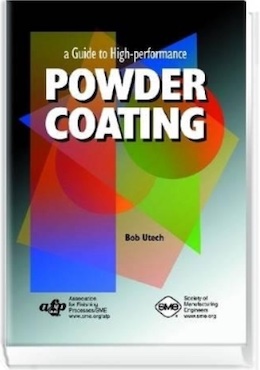
-----
Powder paint cure problem: poor impact resistance
Q. I have a problem with curing powder coat paint on an aluminum product. The paint is rated at 160 inch pounds impact without chipping. However, I have not been able to sufficiently achieve this.The paint manufacturer says I need an oven temperature of 400 degrees for 10 minutes. I have used an electronic Data recorder to set conveyer speed and oven temperature to assure that I meet this requirement. But, I am still having a large number of parts failing to cure properly. The part will pass a "cross hatch" test, and are within "gloss" standards. But, fail the impact test. Although I reach the needed Temperature for the proper time according to my data. The part quickly heats up from under 100 degrees to the 410 degrees mark in just under 10 minutes than holds at the needed temperature for 10 minutes 30 seconds, then quickly drops down to below 275 degrees. could this rapid change in temperature be part of my problem?
Paul Murdock- Alexandria, Virginia
2002
A. Hi Paul,
I always thought that the impact test measured a paint film's ability to adhere to a surface after being severely dented on impact. I didn't think it had much to do with whether the paint had cured completely. Does the paint have a spec for MEK rubs? If so, you can check to see if your painted parts meet the spec. If they do, then you don't have a curing problem. If you have an adhesion problem, maybe it is related to the aluminum pretreatment.
Does the paint supplier's spec for the impact test describe the pretreatment that is used on the metal surface? If your pretreatment is different, then you may not get the same result in the impact test. You should also make sure that whatever pretreatment you are using is within the recommended parameters.
George Gorecki- Naperville, Illinois
2002
A. I don't believe your rapid cooling down is responsible for your impact resistance failure. You may contact the powder manufacture to see if he has a harder coating available, or if you might try a different pretreatment such as a wash primer.
Kenneth SpielmanChicago, Illinois
2002
A. Paul,
I have never really seen anyone perform an impact test upon an aluminum test panel. What grade is the aluminum? The reason impact testing is not done upon aluminum is because aluminum simply cannot take the impact pressure. I assume that you are then testing upon a steel surface. Remember that when we specify temperature specifications, it means that the substrate must see that temperature for 10 minutes, not just be exposed to the temp that long. To test this, I would take a commercial "steel" test panel and coat it with your topcoat. Put it in your oven for at least 15 minutes. Most topcoats will easily survive an over cure. Then test it. It should be cured. If not, have the powder vendor send you a panel painted with the same lot number you currently are painting and see if their panel is cured. If it is, check your pretreatment.
Chipping is not always related to under cure situations. It may be that your aluminum is not getting the etch it needs to secure the topcoat. What exactly is your pretreatment process? Generally a high alkaline or acidic cleaner will give very good topcoat performance and meet your specifications. Also, make sure that you give your parts proper rinses after. Remembering that any Total Dissolved Solids "TDS" that remains in the rinse water, end up on your parts, which could sacrifice your specification/s.
 Bob Utech Benson, Minnesota |
 Ed. note: Bob is the author of: "High Performance powder Coating" on eBay or AbeBooks or Amazon [affil link] |
A. Paul,
Always look at your pretreat, then step your way through your process.
1)are you running your process within specification of your supplier recommendations?
2)you are positive that you acquired (metal temperature)to achieve cure schedule,at required cure time?
3)do all shape and configurations of parts fail?
Not knowing your pretreat practices, part configuration(density,racking,etc.)several factors may be involved. Pretreat of aluminum on a production line requires constant vigilance, cleaning,rinses and etch merely set the stage for non chrome seal, if this is what you are using. Final pretreat, prior to topcoat, whether liquid or powder will be the key to consistency knowing you have your cure schedule decisive.
Steve Wolfbauer- Anderson, South Carolina
2003
A. Impact Resistance is typically a "formulated" property. It is tested on ACT or Q panels in the powder coat manufacturers lab, and the test usually has no use at the point of application due to varying substrate composition and thickness. The best thing you can do is receive a supplier C of A that it passed impact under their controlled environment, etc. The most pertinent tests at the point of application on production parts are:
1) Cross Hatch Adhesion
2) Solvent (MEK) Rub
3) Pencil Hardness
4) Gloss
5) Film Thickness
automotive components - Grand Rapids, Michigan
2003
A. Paul,
What type of powder are you using? When the company I work for began powder coating our aluminum door line we used a urethane based powder from Sherwin Williams. Of course the engineering dept didn't bother to do any testing prior to ordering a couple thousand pounds. We experienced the same type of symptoms you are describing. And of course Sherwin Williams blamed cure and pre treatment initially, however after switching to a polyester hybrid the problems disappeared. Nothing like throwing away several thousand dollars worth of powder due to listening to a salesman rather than real world testing......
powdercoat - Dixon, Illinois, USA
November 4, 2009
Poor impact resistance of Powder Coating on top of CED Coating
Q. we would like to know that how to improve impact resitance of Powder Coating which is being done on CED (Cathode Electro Deposition ) Coating. And Impact required is 150 Kg.cm immediately after application and after 24 hours as well?
Gurpreet Singh- Sahibabad, India
April 25, 2017
Ed. note: This RFQ is outdated, but technical replies are welcome, and readers are encouraged to post their own RFQs. But no public commercial suggestions please ( huh? why?).
A. Hi Gurpreet. We added your inquiry to a thread which was already addressing this problem. You may also find the "Powder Coating over CED Coating Fails Impact Test" subheading section of letter 23620 helpful. Good luck.
Regards,

Ted Mooney, P.E. RET
Striving to live Aloha
finishing.com - Pine Beach, New Jersey
Ted is available for instant help
or longer-term assistance.
April 2017
Q, A, or Comment on THIS thread -or- Start a NEW Thread